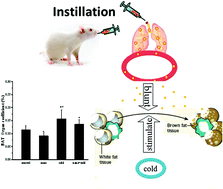Inhaled SiO2 nanoparticles blunt cold-exposure-induced WAT-browning and metabolism activation in white and brown adipose tissue
Abstract
Concern has been growing over the potential hazard of nanoparticles to human health because of increasing ambient particulate air pollution. Much research has been performed on the toxicology of nanoparticles to organs. Meanwhile, particles floating in air, particularly in winter, are more serious. Thus, the purpose of this study was to evaluate the effect of nanoparticles and cold on human health. There is little research on the effects of nanoparticles on energy metabolism. The composition of particulate matter is complicated; however, silicon in particles accounts for a significant proportion. Adipose tissue is the main organ that produces heat and maintains the body temperature in a cold environment. White adipose tissue (WAT) stores energy in the form of triacylglycerol, whereas brown adipose tissue (BAT) dissipates energy in the form of heat to maintain the body temperature. This article presents the effect of air ultra-particles and cold on the WAT and BAT. In vivo, Sprague-Dawley rats were divided into four groups: exposed to the same deposited doses of silicon dioxide (SiO2) nanoparticles (NPs) by intratracheal instillation or/and cold exposure at 4 °C, 4 h per day for four weeks. Cold exposure induced weight loss and WAT browning, as indicated by pathology, transmission electron microscopy (TEM), upregulated mRNA levels of BAT and WAT specific genes and molecular switches. Intratracheal instillation of nano-SiO2 induced a slowdown in metabolism, weight gain and inhibited WAT browning, as indicated by the downregulated mRNA levels of BAT and WAT marker genes and molecular switches. This study provided direct evidence that SiO2 NPs might inhibit the effect of cold-induced white/brown adipose tissue changes in plasticity and metabolism.


 Please wait while we load your content...
Please wait while we load your content...